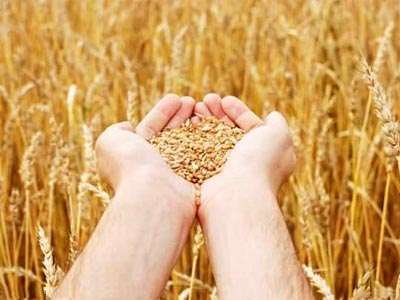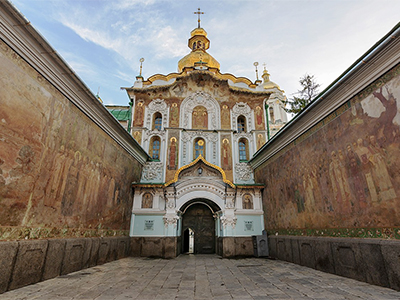 30.03.2023
Agriculture: a few basic concepts associated with Ukraine
30.03.2023
Agriculture: a few basic concepts associated with UkrainePlants and their cultivation are very important in Ukraine, not only because agriculture is an important part of its economy but because Ukrainians love nature and love to grow things. They enjoy plants for their beauty as well as value them for their usefulness.
A few basic concepts associated with Ukraine
The steppe (степ) is the broad band of grassland covering almost the entire southern part of Ukraine up to the foothills of the Crimean Mountains. Like the American prairie, almost all of the steppe’s wild grass vegetation has given way to cultivation.
Chornozem (чорнозем) is the rich fertile soil that covers almost half of Ukraine, primarily the steppe belt. Chornozem is a thick layer of dark grey soil with a definite granular-lumpy structure and a high content of decomposed matter. The chornozem layer is soft and absorbs water and air well, promoting bacterial development and plant nourishment. Deep plowing increases the fertility resulting in the highest possible yields of all types of agricultural crops.
Ukrainian agriculture is based on collectivization, which was forcibly introduced in the late 1920’s and early 1930’s as a means of providing the state with maximum cost-free capital for developing heavy industry, supporting the military, and maintaining the bureaucracy. A typical collective farm, a kolhosp (колгосп), has about 1000 hectares of land.
The state farm or radhosp (радгосп), more common in southern and central than in western Ukraine, is a more socialist form of agricultural organization than the collective farm, with the state owning not only the land but the means of production as well. State farms tend to be larger than collective farms.
A hectare (гектар) or 10,000 square meters is approximately 2.5 acres.
With Ukraine’s reputation as the “breadbasket of Europe“, it’s not surprising that grains are the most important crops. Millet, spring wheat, and barley cultivation date back to the Trypilian period (4,000-3,000 B.C.), rye appeared a couple of thousand years later, buckwheat in the first century A.D., followed by oats. Com cultivation dates to the eighteenth century and rice didn’t come into use until after World War n. Today the total grain harvest ranges from 40 to 50 million tons per year.
The mainstay of Ukrainian grain crops is wheat, especially winter wheat. The black soil (chomozem) and the warm, moderately rainy summers, primarily in southern and eastern regions of the country, provide ideal conditions for its cultivation. Here are the major crops: barley, buckwheat, corn, millet, oats, rice, spring wheat, rye, wheat.
Many plants are grown for their culinary flavor, for or for their yield of essential oil, Roots, leaves blossoms, buds, berries or seeds of the following are commonly used for cooking or healing: basil, belladonna, blueberry, chamomile, caraway, dill, foxglove, lavender, mint, parsley, poppy, rose, sage and others.
Special Plants
Plants figure in story, song, and legend. Here are a few that have special meaning for Ukrainians:
Chestnut (каштан) is the symbol of Kyiv. Huge chestnut trees line the main streets and avenues of the city. The hard currency shops are named for the chestnut.
Cherry (вишня). The luscious, deeply-flavored tart sour cherry is one of the most popular fruits in Ukraine. The leaves are added to pickles to lend flavor. The beautiful tree is abundant throughout Ukraine and in early spring their blossoms make a spectacular show. The cherry orchard is the theme of a much-loved Shevchenko poem which was made into a popular song.
Garlic (часник) is undoubtedly one of the most important plants in Ukrainian folk medicine and a primary ingredient of Ukrainian cuisine. It is not eaten to cure any particular ailments, but to promote general good health and well-being, a practice supported by numerous 20th- century medical studies. Ukrainians usually don’t cook garlic but enjoy it in its raw state, with bread, butter, and salt, or diced into salads.
Viburnum or guelder rose (калина) is an attractive deciduous shrub. Ukrainians also call it the “red snowball tree” because of its cluster of red berries which hang on the tree throughout the winter. The berries have a very high vitamin C content and an infusion of the mature dried berries is used for coughs. Because of the staying power of the berries, the kalyna has become a metaphor for the survival of the Ukrainian nation. Kalyna is the subject of various patriotic songs and the name of various organizations.
Willow (верба). Gracing ponds and riverbanks, the elegant willow lends charm to rural landscapes. At least 30 species grow in Ukraine, hi olden days, fences and baskets were made of willow twigs and the soft, light wood is also used for hand-carved articles such as musical instruments, for example, the bandura. The branches of one species, the pussy willow, are used on Palm Sunday instead of palm fronds.
Beekeeping
Some plants are important in Ukraine because their blossoms provide nectar for bees. Wildflowers, buckwheat, clover, and linden blossoms are the primary types of honey. Each has a distinct color and flavor, ranging from light and delicately flavored wildflower honey to the dark, strong tasting buckwheat.
Beekeeping or agriculture has been widespread in Ukraine since ancient times but declined in the 17th and 18th centuries with deforestation that cultivation of the steppes, and the prominence of sugar. In the first half of the 19th century agriculture was revived and entered a modern period with the invention of the first frame hive by Peter Prokopovych, a landowner in the city of Chernihiv area. By the eve of the World War I, beekeeping was highly developed in Ukraine with about 2 million hives. With collectivization nearly all collective forms began to keep bees. While beekeeping still remained a popular individual enterprise, the collectives became the primary source of honey production in Ukraine. Apiculture is most developed in the forest-steppe region and in the steppe region.
❤️ Explore the secrets of beekeeping in the Carpathians during our Do Nothing Tour. Book NOW!
Ukrainians value honey not only for its sweetening ability but also for its medicinal properties. Several books have been published in Ukraine about the use of honey as treatment for many deceases, especially those of the lungs, throat, and skin. The propolis, a sticky substance bees collect from buds, is a powerful antibiotic against bacteria.
-
 27.02.2024
World of pysanka
Embark on a journey into the captivating world of Pysanka, the Ukrainian...
27.02.2024
World of pysanka
Embark on a journey into the captivating world of Pysanka, the Ukrainian...
-
 29.01.2024
Exploring the Treasures of Kyiv’s Lavra Monastery
In the heart of Kyiv lies the venerable Lavra Monastery, a testament...
29.01.2024
Exploring the Treasures of Kyiv’s Lavra Monastery
In the heart of Kyiv lies the venerable Lavra Monastery, a testament...
-
 13.01.2024
Kachanivka, Eden on Earth
Rich in history, it hosted renowned artists, notably poet Taras Shevchenko.
13.01.2024
Kachanivka, Eden on Earth
Rich in history, it hosted renowned artists, notably poet Taras Shevchenko.

